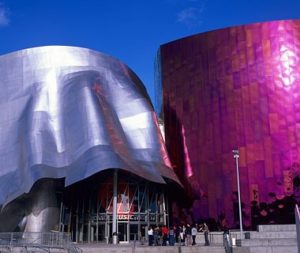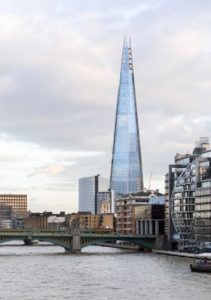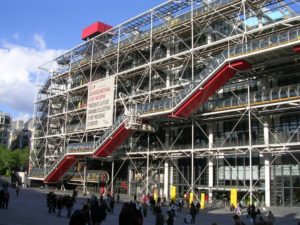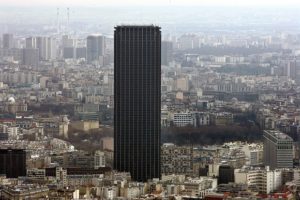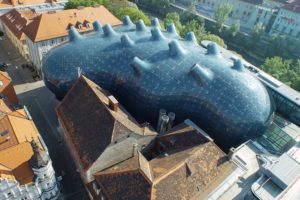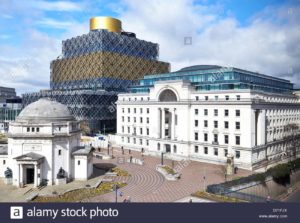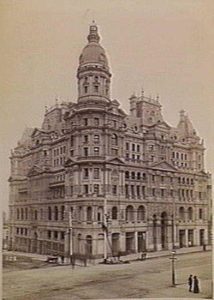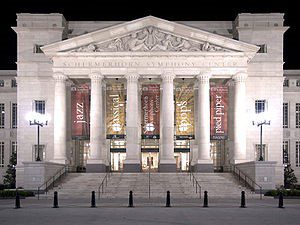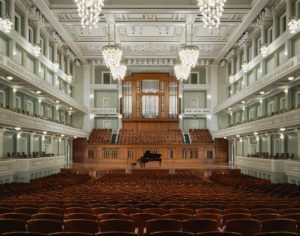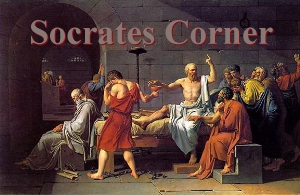Architecture designed to kill the Human Spirit, Part II
The Portland Building by Architect, Michael Graves (Portland, Oregon)
| About the Author—Professor Ellis Washington, J.D.—I went to Harvard Law School with future POTUS Barack Hussein Obama for 1 year (1988-89), but I took the opposite path in Life—New World Order, Communism, Treason, Pedophilia & Satanic Ritual Abuse vs. Christianity, Conservatism, Protecting the Children & TRUMPism. I repeatedly refused to take the “Satan OATH” which is why I’ve been blacklisted for 30+ years—for my entire legal and academic career, yet I Fight on! Why?—For Harvard’s original 1692 motto—Veritas pro Christo et Ecclesia {= Truth for Christ and the Church}.
To escape the 150-Year Rothschild Chattel Slavery systems (e.g., Birth certificates, Social Security numbers bought, sold & traded on Wall Street) & Rothschild Debt Slavery systems (e.g., IRS, Income Taxes, fiat/counterfeit currency based on NOTHING, printed to fund false flag wars) of the Rothschild Khazarian Mafia Matrix (1871-2021), read and share the Truth of my Critical Thinking blog with the Youth that’s nearing 20 Million views @ EllisWashingtonReport.com & on Facebook — #JesusIsLord #DCActof1871 |
The Mother art is architecture. Without an architecture of our own we have no soul of our own civilization.
~ Frank Lloyd Wright
Architect Louis Sullivan’s doctrine [“Form follows function”] has been used to justify the greatest crime against beauty that the world has yet seen and that is the crime of modern architecture.
~ Architecture Documentary
The despairing malaise that seems to hang heavy in the UK air permeates from these concrete monuments to misery up-and-down the country. And if anyone’s to be blamed its Nazi collaborator Le Corbusier.
~ Paul Joseph Watson
The Renzo Piano Invasion of London
PAUL JOSEPH WATSON: [@ 9:05] The Shard in London, a glassy vulgarity that wouldn’t look out of place in Dubai. Pretty appropriate given that Gulf-Arab money now owns about half of England’s city; another reminder that gigantism has superseded elegance and intricacy. Another homage to nothing more than architect Renzo Piano’s ego. Whose idea was it to let the designer of this eyesore defaced London’s already scarred skyline?
The Shard in London
Centre Georges Pompidous, by Renzo Piano and Richard Rogers (Paris, France, 1977)
Here’s another of Piano’s atrocities, the Whitney Museum (below), a modern art gallery of $422 million abortion-of-a-building, that looks more like a secret police torture chamber than an art gallery, but at least they provide diving boards for its visually traumatized inhabitants to commit suicide.
Whitney Museum by Renzo Piano (Manhattan, New York, 2015).
PAUL JOSEPH WATSON: Look at this grim intruder onto the otherwise majestic skyline of Paris, Tour Montparnasse. The authorities must have realized the hideous mistake
when they banned buildings over seven stories tall just two years after its completion, but the damage was already done. “It combines size and inescapability with banality rights,” says Dalrymple. “I cannot see it without feeling a surge of anger. And [ironically] the best view of Paris is from the top of Montparnasse.”
Tour Montparnasse (Paris, France, 1969-73)
Yet the biggest Montparnasse can’t be seen in the constant drafts in Austria. And of course, it’s a modern art museum that looks like a malevolent alien spaceship has just landed and its inhabitants are about to incinerate the population War of the Worlds style.
Modern Building of Kunsthaus Museum of Contemporary Art by Architects Peter Cook and Colin Fournier in Graz Styria Austria
PAUL JOSEPH WATSON: Look at this monstrosity, the School of Engineering and Technology in Peru. Listen to how one of the architects describes it— “We’re interested in weight. For us the enjoyment of architecture is the sense of weight being borne down or supported, the feeling of moving with the forces of gravity. It’s a very primal need.” Total nonsense! You don’t look at the Taj Mahal and think of the sense of weight being borne down. That’s just pretentious obscurantism to disguise the fact that the building is ghastly.
New Campus for the University of Engineering and Technology UTEC, Lima, Peru.
Look below at a time lapse of Birmingham (beg. @11:13) – majestic, stirring buildings heartlessly razed to make place for a library that looked more like a place to burn books than to keep them.
Old Library, (London, England)
New Library, (London, England)
The old library was demolished a couple of years ago then replaced with this [above left corner] which can be considered even worse.
Boston Brutalism in the ‘Age of Ugliness’
JAMES KUNSTLER: Look at the callous abomination which is Boston City Hall… A public space so dismal that not even winos want to go in there. There is not enough Prozac in the world to make people feel okay about going down this block.
Boston City Hall (1968), a prime example of Brutalist architecture style.
PAUL JOSEPH WATSON: Why did they design it like this? Why the daunting exterior combined with the expansive, foreboding, shadeless open space in front? Again, it’s about using oppressive Brutalism to exert authoritarian control over the population.
JAMES KUNSTLER: This would be a better building if we put mosaic portraits of Joseph Stalin, Pol Pot, Saddam Hussein, and all the other despots of the twentieth century on the side of the building, because then we’d honestly be saying what the building is really communicating to us. It’s a despotic building that wants us to feel like termites.
PAUL JOSEPH WATSON: Melbourne’s Federal[ist style] Coffee Palace is an ornate wonder, demolished and replaced with a bland office tower. The most shocking thing about all of this is that the appetite for Modernist monstrosity in architecture only seems to be increasing. Le Corbusier isn’t reviled, he’s worshipped by other architects. In the 2009 poll it showed the public preferred Traditional architecture to Modernist architecture, but more recently attitudes seem to be changing. People queued up around to block to sign contracts to live in this deformed black box in Washington, D.C. Living spaces are getting smaller as the population becomes more atomized and isolated.
Melbourne Coffee Palace (1888-72)
Micro or “Coffin” Apartments (Manhattan, New York)
Coffin apartments or micro apartments are taking over major city centers, similar to how they rewired our brains to enjoy dumbed-down repetitive pop music. We’ve been indoctrinated into believing that vulgar is cool. In smaller cities and suburbs instead of mixed use environments, everything is segregated. The tyranny of zoning has created austere pockets of hopelessness separated by vast, soulless highways. This mechanically crushes any prospect of community or municipal dignity.
JAMES KUNTSLER: We cant overestimate the amount of despair that we are generating with places like this.
PAUL JOSEPH WATSON: We are witnessing the uglification [sic] of the world, the Globalist goal is to make the whole planet identical in its atomizing dreariness by dulling our senses they hope to dull our very life essence. This is all inherently totalitarian, but in an Age of Ugliness a work of beauty is an act of defiance and thankfully there are still small pockets of resistances.
Advocates of Neo-Traditional architecture survives and they’re still erecting buildings like the Schermerhorn Symphony Center in Nashville and the entire town of Poundbury in England. So, this isn’t a rant against modernity. I’m not saying that every building should be a pastiche or a facsimile. It’s a rant against the hostility to the past that dominates post-modernist architecture. Just of and deal about the past dominates virtually every aspect of post-modernism. It’s a rant against the contrived exaltation of vulgarity which is being used as an insidious form of social engineering.
Schermerhorn Symphony Center in Nashville, Tennessee
Just like in art, entertainment and music we need to rail against the Relativist, Collectivist, Postmodernists lie that objective standards of beauty don’t exist. They do exist, they always will and while taste will always be subjective, we must never accept ugliness as a form of beauty.
Epilogue to Postmodernism—The “Opposite Paradigm”
The “Opposite Paradigm” is a phrase I coined a few weeks ago. Here, I would like to apply my theory to this modern critique on Aesthetics. It is how I defined the Leftist tendencies in modern times to weaponize Progressive thought, Socialist ideology to silence all detractors through systematic perversion of the language to be interpreted to be the opposite of what they actually write or intend. Thus, Rationalism and rational people who believe in objective truth and logic are ridiculed as “enemies of progress” because they refuse to bow or submit to the totalitarian fascism of the State.
SOLUTION: Understand Progressive propaganda to be interpreted the opposite of what “enemies” of Progressivism actually mean. If the Progressive Revolution (1860 – present) or the apotheosis of Evolution Atheism has taught U.S. anything it is that to make sense of our Alice in Wonderland perversion that is the Progressive Revolution or here, Modernism and Postmodernism tendencies of weaponizing art and architecture to destroy a true and enlightened Aesthetics, simply reinterpret what you see through the lens of opposites where God, Reason, Rationalism, Objectivity and Veritas (truth) rule supreme which will always (despite the chattering of Useful Slaves) lead you “down the paths of righteous for His namesake.” This metaphysical Life Guide others call conscience, a ‘gut-feeling’, a ‘Sixth Sense’ or Guardian Angel, is what the ancient Greeks and Romans codified as Natural Law.
David Adams in his 1992 book, Philosophical Problems in the Law, defined Natural Law as “consists of “principles and standards not simply made up by humans but rather part of an objective moral order, present in the universe and accessible to human reason.” Thomas Jefferson, in his Declaration of Independence, summarized Natural Law philosophy inherent throughout the Constitution as “… the law of Nature and of Nature’s God.” The original intent of the Constitution’s Framers understood that liberty, justice and Veritas (truth) could only be achieved when law and morality were NOT at war one with the other, which I called, “The Inseparability of Law and Morality,” to do otherwise is tantamount to building a skyscraper on a foundation of sand—it will soon collapse into a spectacular and tragic catastrophe. Most Modernist and Postmodernist architecture is specifically designed for destruction. Therefore, just as the Rule of law must have its foundations based in transcendent principles of Natural Law, Natural Rights, so must great Art, great Architecture pay homage to its Traditionalist past otherwise as Frank Lloyd Wright warned, “… without an architecture of our own we have no soul of our own civilization.” I would further conclude that without an architectural “soul” neither architecture or society has a viable future.
Socrates and the “Wagnerian Dilemma”
When you boil it all down what is great Art? What is great Architecture? In a 2010 Socratic dialectical essay I wrote titled—Symposium: Art, Music and the Wagnerian Dilemma, I presented this narrative regarding this existential inquiry of the ages.
Socrates: To us, the ancient Greeks, the very idea of an intentional fallacy, the notion that one can separate art from beauty would have been readily dismissed, as for them the notions of beauty and moral goodness were inextricably linked, yet due largely to the modernist philosophy of relativism – the concept that points of view have no absolute truth or validity and have only relative, subjective values according to differences in perception and consideration – this question has proved more troublesome for the modern mind.
Ezra Pound: Socrates, I disagree, for artists themselves tend to be relatively indulgent, amongst whom the poet is typical, and therefore good art, however “immoral,” is wholly a thing of virtue. Good art cannot be immoral. By good art I mean art that bears true witness.
True Art and Architecture, Great Art and Architecture, Transcendent Art and Architecture is a form that endures through the Ages. The highest form of Art and Architecture must metaphorically speaking, ascend the Steps of Parnassus. True art and architecture, even art and architecture considered for whatever reason to be deemed “immoral” must endure the test of time, but most importantly must in the words of Ezra Pound, “bear true witness”. Bear true witness to what? I’d like to think the answer is good architecture must bear some form of true witness to an existing past—to eternal, existential principles of Veritas and Realism, Reason and Objectivity, Form and Function. Otherwise ugly art and perverted architecture will only usher in a future dystopia, not a welcomed utopia.
Thank you, Paul Joseph Watson for your passionate and prescient insights about Aesthetics and for “Bearing True Witness” to Reason, Objectivity, Truth and Transcendence and eloquently speaking against or “railing” against those popular potentates of Progressivism, Post-Modernism and Ugly architecture. Thank Heavens most of their insipid rubbish has been destroyed or ignored to pave the way for a New Age of Neo-Traditionalist architecture that will uplift and inspire the more intractable qualities of Human Nature; to enlighten, educate fortify the intrinsic qualities of the Human Spirit, not an architecture that is systematically weaponized by Nazi-sympathizing architects like Le Corbusier, like Michael Graves, like Renzo Piano and legions of other fraud “architects” to depress and deconstruct; an architecture designed to pervert and ultimately to kill the Human Spirit. We the People must battle against what Paul Joseph Watson declared that most Modernist and Postmodernist architecture is— “about using oppressive Brutalism to exert authoritarian control over the population.”
We the People demand an architecture of Liberty and Freedom. Nevertheless, we will not allow Modernism and Postmodernism, this aesthetic authoritarianism to conquer our Human Spirit. We the People must awake from our collective ignorance, indifference, and slumber to fight against all forms of institutional ugliness in all of its functions, forms and consequences—an architecture that German-American architect, Ludwig van der Rohe (1886-1969) called to chronicle “the history of epochs and gave them their names.”
Category: Commentary


